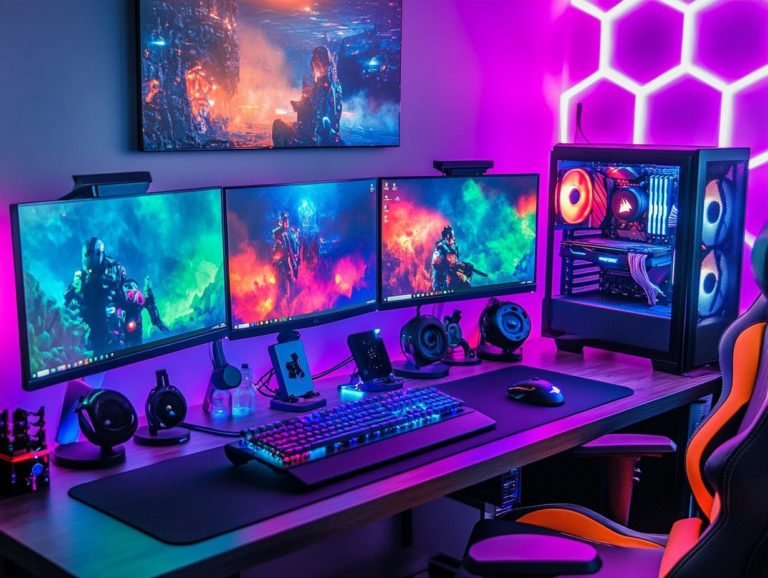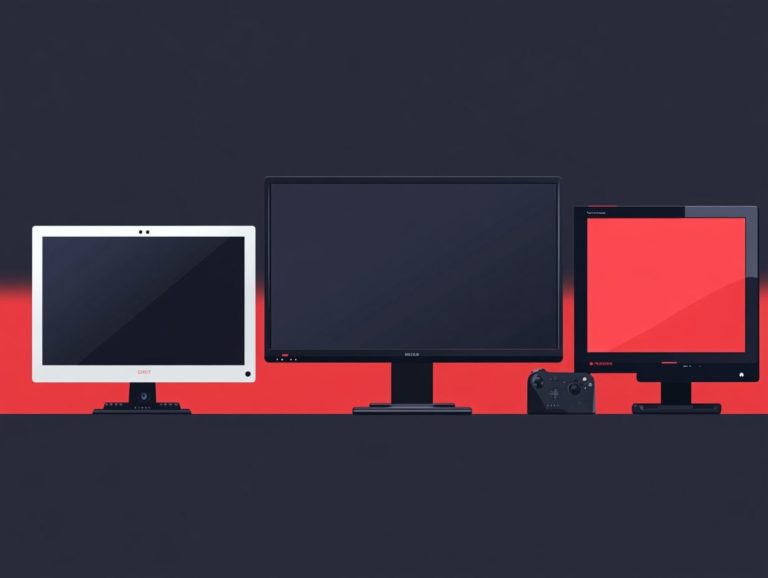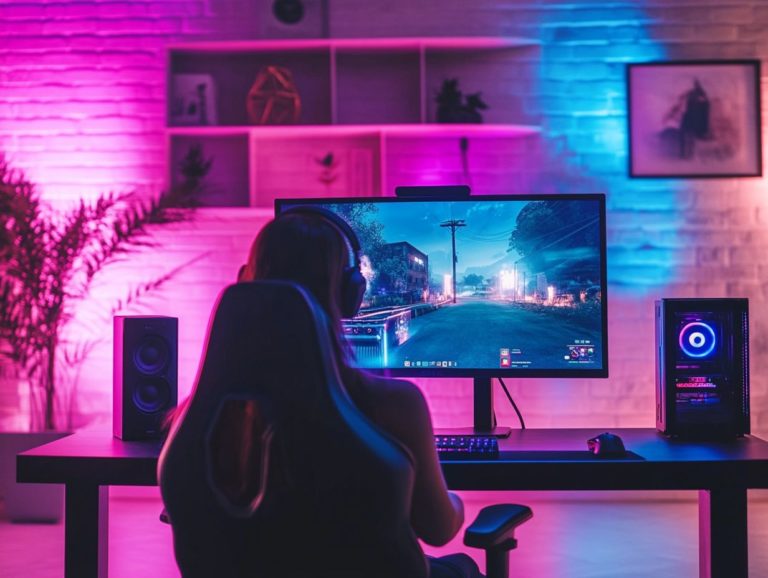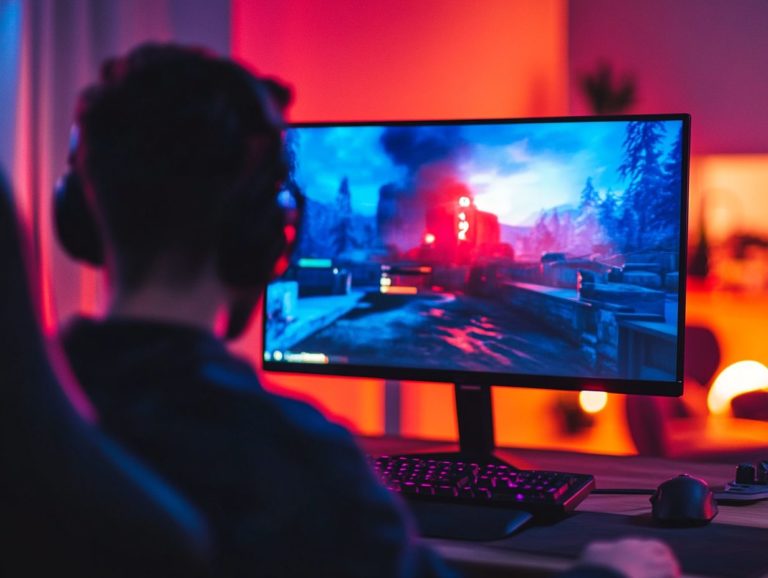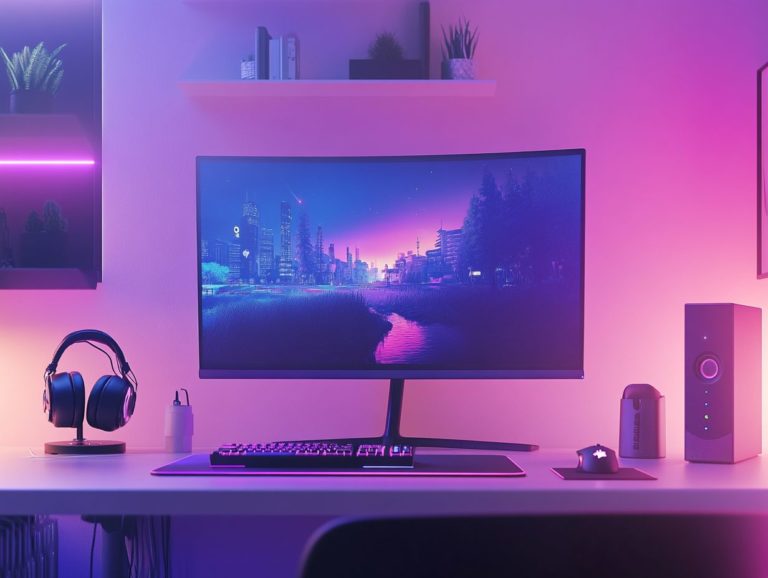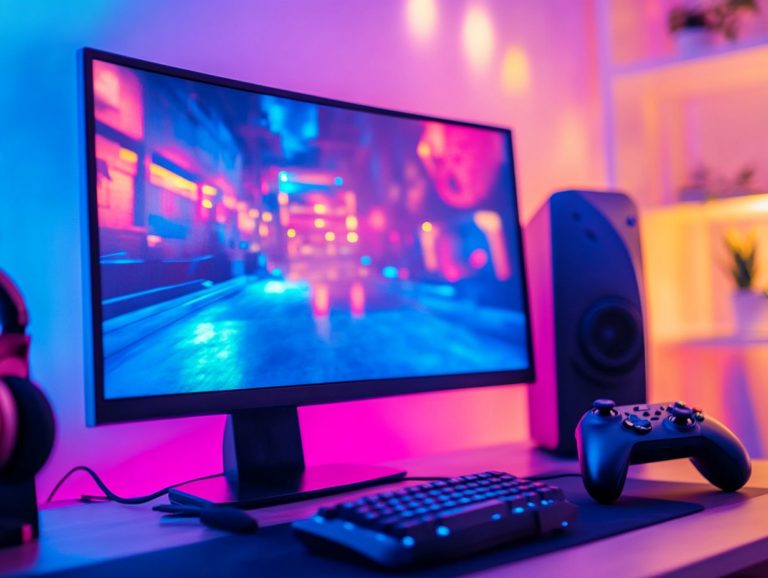how to set up your gaming monitor for fps games
Choosing the right gaming monitor can significantly enhance your FPS gaming experience.
There are many specifications and features to consider. It s essential to understand what truly elevates your gameplay. Every detail matters, from resolution and refresh rate to the delay between your actions and what happens on screen, all contributing to sharp visuals and seamless motion.
Get ready to optimize your monitor settings and elevate your game! This guide will help you explore additional features and calibrate for peak performance.
Contents
- Key Takeaways:
- What Makes a Good Gaming Monitor?
- Optimizing Settings for FPS Games
- Additional Features to Consider
- Calibrating Your Monitor for Optimal Performance
- Frequently Asked Questions
- What is the optimal resolution for playing FPS games on a gaming monitor?
- What is the ideal refresh rate for a gaming monitor when playing FPS games?
- Should I use a curved or flat monitor for FPS games?
- How should I adjust the brightness and contrast settings on my gaming monitor for FPS games?
- What are the Best Color Settings for FPS Games?
- Should I Enable Special Features on My Gaming Monitor?
Key Takeaways:
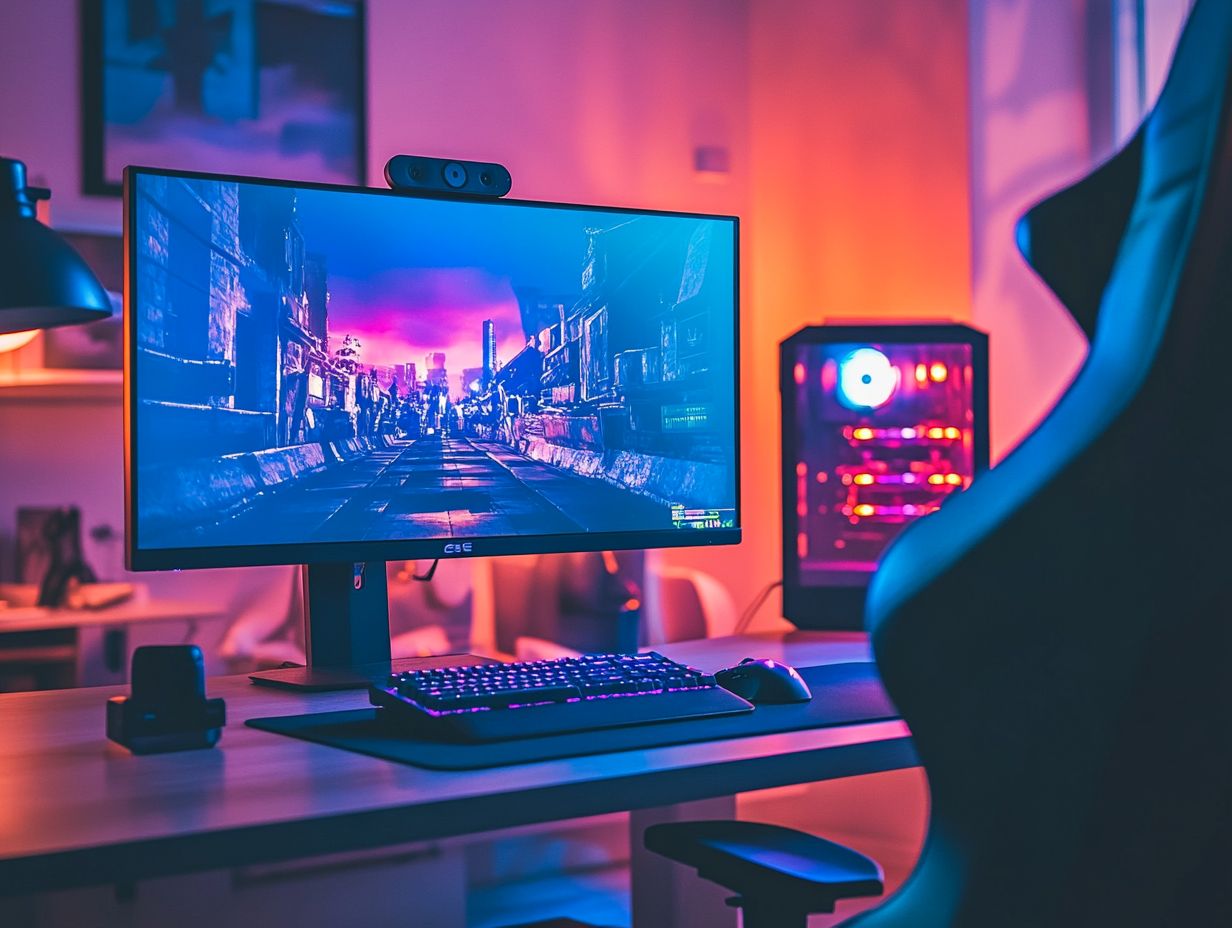
Choose a gaming monitor with a high resolution and refresh rate for smoother gameplay. Consider delay and response time when selecting a monitor to ensure fast and accurate responses to your actions. Additionally, utilize monitor calibration tips for gamers to adjust color and contrast settings for better visibility and accuracy in FPS games.
What Makes a Good Gaming Monitor?
A high-quality gaming monitor should seamlessly blend a high refresh rate, exceptional color accuracy, and customizable settings. This is particularly important for competitive gamers who benefit from adaptive sync technologies like G-SYNC and FreeSync. These technologies help match the monitor’s refresh rate with the graphics card’s output, reducing screen tearing.
Key aspects such as brightness settings, response time, local dimming, and monitor calibration are essential for optimizing your gameplay. These elements help you enjoy vibrant colors while minimizing distractions during intense FPS moments.
Optimizing Settings for FPS Games
To truly optimize your gaming monitor for FPS games, adjust the settings to enhance both responsiveness and visual clarity. For detailed instructions on achieving this, refer to our guide on how to sync your monitor with your gaming PC. Pay close attention to key features such as refresh rate, delay, and response time.
By fine-tuning your display settings particularly color accuracy and monitor calibration you can dramatically enhance your performance and immersion in fast-paced gaming experiences.
Resolution and Refresh Rate
The resolution and refresh rate of your gaming monitor are key factors that shape the visual quality and smoothness of your experience in FPS games. A higher refresh rate means more frames per second, greatly enhancing gameplay fluidity and responsiveness.
The right settings can greatly improve your gaming, especially in competitive environments. Many competitive gamers opt for a resolution of 1920×1080 paired with a 144Hz refresh rate to achieve an ideal balance between crisp imagery and fast-paced action.
This setup helps minimize motion blur and screen tearing, allowing you to track opponents more easily during intense skirmishes. If you’re looking to take it up a notch, 240Hz monitors can boost your responsiveness even further, providing an edge in those split-second decisions that can make all the difference in high-stakes games like Call of Duty or Valorant.
Ultimately, the right resolution and refresh rate enable you to fully immerse yourself, react with agility, and maintain that competitive advantage you crave.
Input Lag and Response Time
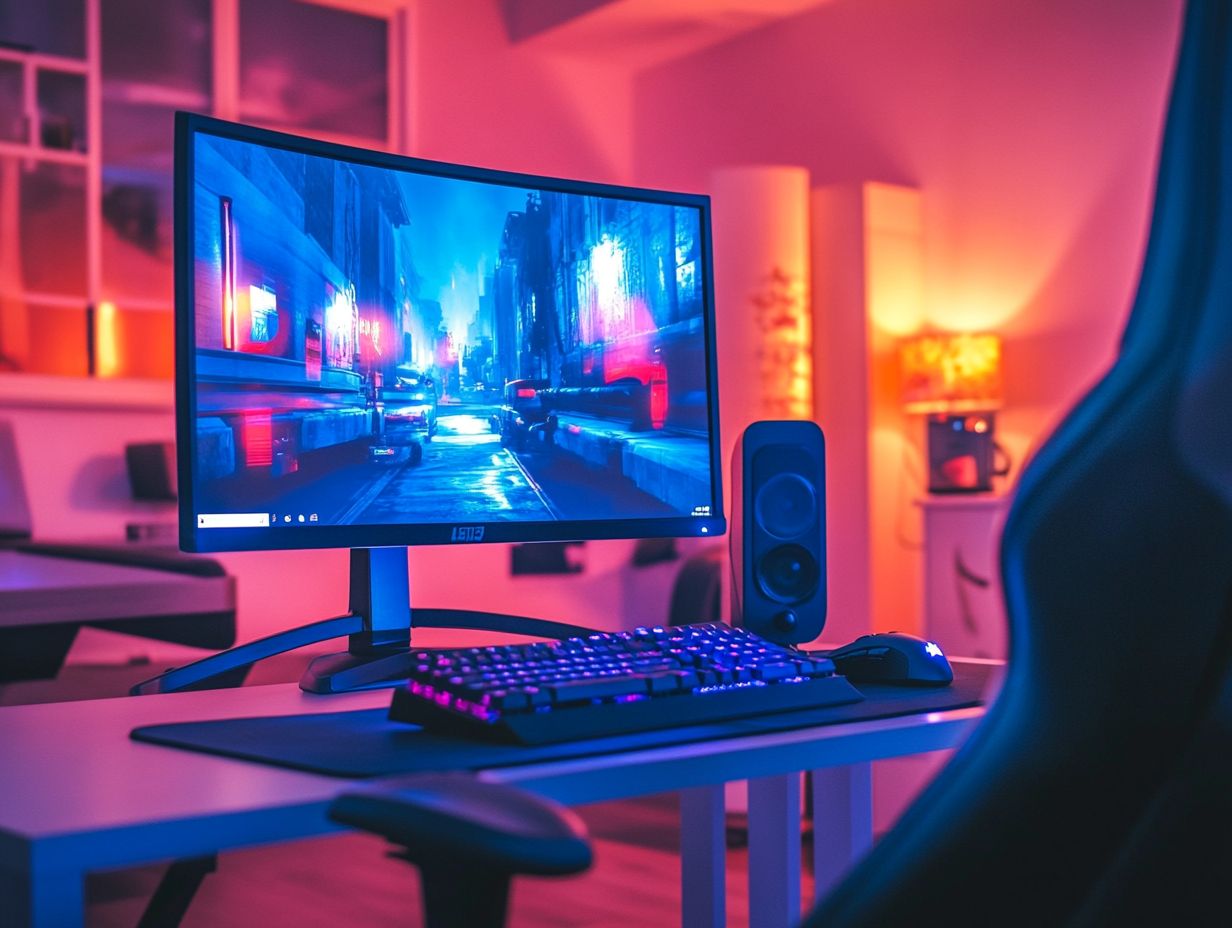
Input lag and response time are critical metrics for your gaming monitor, directly affecting your overall experience. Lower input lag means your commands are executed almost instantly, while fast response times significantly reduce ghosting issues.
These features are crucial for competitive gamers, so prioritizing them can provide that coveted edge. In fast-paced FPS titles, every millisecond counts; the difference between victory and defeat often hinges on your monitor’s performance.
High input lag can create a frustrating delay between your actions and the game s response, potentially costing you valuable shots. Similarly, slow response times can lead to blurring or ghosting effects during rapid movements, obscuring vital details that could impact your strategy.
To avoid these pitfalls, invest in monitors that offer low input lag ideally under 5 milliseconds and response rates of 1 millisecond or faster. Consider models from reputable brands like ASUS, Acer, and Dell, which are highly recommended for competitive gaming.
This way, you can enjoy smooth visuals and responsive gameplay without unnecessary distractions. Check out these tips to ensure your gaming monitor performs at its best!
Color and Contrast Settings
Fine-tuning the color and contrast settings on your gaming monitor can elevate your experience to new heights. With enhanced color accuracy and visual appeal, you ll revel in vibrant hues and improved image clarity during gameplay.
Using color settings that allow you to display colors accurately will immerse you completely in the rich graphical details that modern games offer. To achieve optimal visual performance, explore the various color modes your monitor provides, such as sRGB, Adobe RGB, or DCI-P3. Each mode is crafted for different content types, allowing you to tailor your experience.
Adjusting brightness and contrast levels can make a world of difference, making colors pop and become even more striking during those high-octane scenes. Utilize built-in calibration tools or third-party software to fine-tune these settings to suit your personal preferences.
Don t hesitate to experiment with gamma settings, which adjust the brightness of the midtones in your image, enhancing detail in shadows and highlights. By leveraging these tools, you can significantly enhance your visual experience, making every gaming session not just enjoyable, but truly unforgettable!
Additional Features to Consider
When choosing a gaming monitor, certain features can dramatically elevate your gaming experience.
Technologies like G-SYNC and FreeSync, which eliminate screen tearing and stuttering, are essential for smooth gameplay. Understanding panel types, screen sizes, and aspect ratios is key to optimizing your setup.
Assessing these options thoughtfully will ensure you make the best choice for your gaming needs!
Adaptive Sync Technology
Adaptive sync technology, like G-SYNC and FreeSync, is essential for modern gaming monitors. It synchronizes your display’s refresh rate with your graphics card’s frame rate, significantly minimizing input lag and eliminating screen tearing during gameplay.
This feature is especially advantageous when diving into fast-paced FPS games. By aligning the refresh cycles of both components, you enjoy a more fluid and responsive gaming experience, meaning your movements can be more precise and your reactions swifter.
This is crucial in high-stakes situations where every millisecond counts and can truly affect the outcome of the game. Adaptive sync technology also enhances frame stability across a range of graphics demands, helping you stay immersed in the action without distractions.
The seamless experience not only boosts your gameplay performance but also reduces fatigue during those marathon sessions, allowing you to engage fully with your favorite titles without compromise!
Panel Type
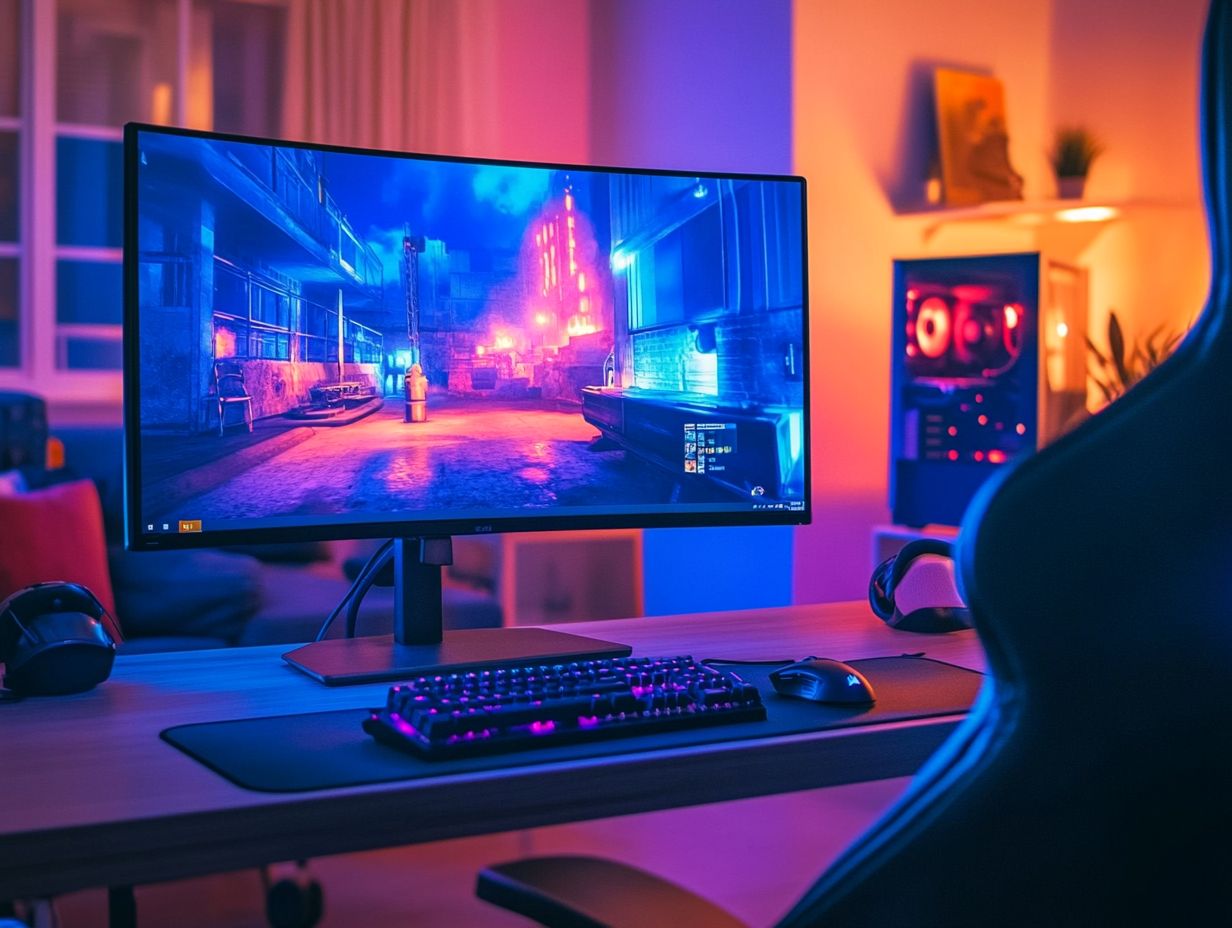
The type of panel in a gaming monitor is crucial for determining display quality. Options like IPS, TN, and VA panels come with various benefits regarding color accuracy, response times, and viewing angles.
It s important to consider which panel type aligns best with your gaming preferences and environment, as each has its unique advantages and trade-offs.
For instance, IPS panels are celebrated for their exceptional color reproduction and wider viewing angles, making them a fantastic choice if you relish vibrant graphics and cooperative gaming experiences. Conversely, TN panels shine in response times, providing ultra-fast refresh rates that can be pivotal in competitive gaming, though they often sacrifice color depth and viewing angles.
Meanwhile, VA panels strike a satisfying balance with better contrast ratios, although they may fall slightly behind in response times. Ultimately, grasping these characteristics is essential for choosing a monitor that meets your specific needs and elevates your overall gaming experience!
Screen Size and Aspect Ratio
Screen size and aspect ratio are essential factors to consider when selecting a gaming monitor. These elements can dramatically influence your immersive experience. A larger screen can create a more engaging environment.
Specific aspect ratios enhance visibility, especially in first-person shooter games. Striking the right balance is crucial for an optimal gaming experience. For instance, a wide 21:9 aspect ratio can envelop you in a panoramic view, significantly improving your awareness of surroundings vital in competitive scenarios.
Conversely, standard 16:9 monitors are popular for their versatility, providing a balanced visual experience without sacrificing performance. Don t overlook ergonomics; you will want a screen size that won t strain your eyes during extended gaming marathons.
Ultimately, finding the right combination of screen size and aspect ratio should align closely with your personal preferences, gaming styles, and the genres you enjoy. Choosing the right setup is crucial for an amazing gaming experience!
Calibrating Your Monitor for Optimal Performance
Calibrating your gaming monitor is crucial for achieving optimal performance and visual quality. This process aligns your color accuracy and brightness settings with your gaming environment.
Using various tools can significantly enhance your gaming experience. Proper calibration can yield more vibrant colors and enhanced contrast, transforming your gaming sessions into a truly immersive visual feast.
Tools and Techniques for Calibration
Utilizing the right monitor calibration software and techniques is essential for achieving optimal settings on your gaming monitor. Various tools are at your disposal to create accurate color profiles and enhance image vibrancy.
Understanding how to apply these tools effectively can elevate your visual performance. Many gamers underestimate the importance of precise color calibration, yet it plays a crucial role in how images render on your screen. Tools like DisplayCAL or the built-in calibration software in your operating system can be invaluable assets in this process.
Employing color grading techniques allows you to identify the correct gamma levels (the brightness of mid-tones) and white balance (the color temperature of the light) to contribute to a more immersive experience.
By implementing proper profiles, you can fine-tune contrast and brightness to suit your personal preferences, revealing details that might otherwise go unnoticed. This optimization not only enhances visual clarity but can also sharpen your reaction times during gameplay, giving you that competitive edge you’re striving for!
Frequently Asked Questions
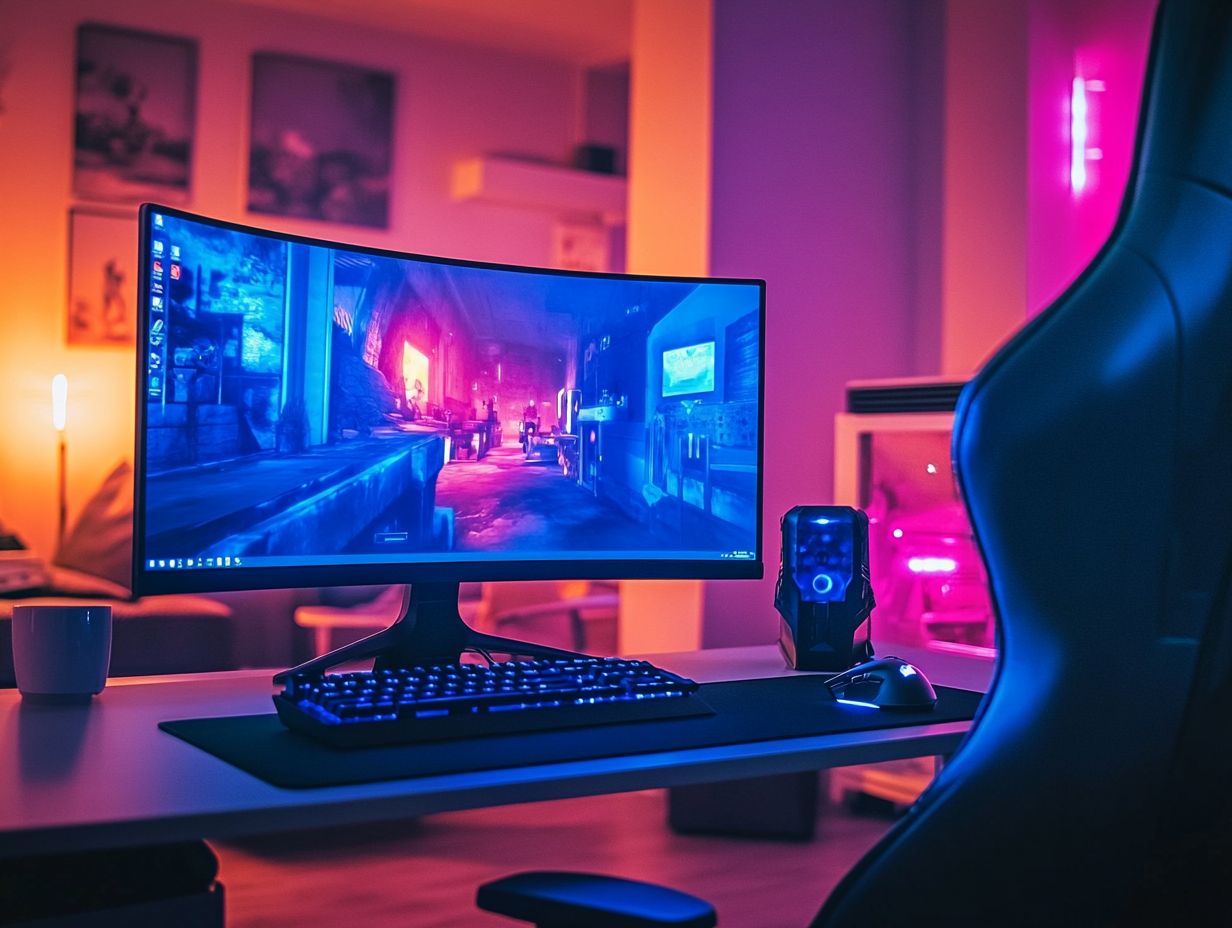
What is the optimal resolution for playing FPS games on a gaming monitor?
The optimal resolution for playing FPS games on a gaming monitor is 1920×1080. This resolution provides a balance between visual clarity and performance, allowing you to see more details in the game while maintaining a high frame rate.
What is the ideal refresh rate for a gaming monitor when playing FPS games?
The ideal refresh rate for a gaming monitor when playing FPS games is 144Hz. This high refresh rate allows for smoother gameplay and reduces motion blur, giving you a competitive advantage in fast-paced games.
Should I use a curved or flat monitor for FPS games?
It ultimately comes down to personal preference, but many gamers prefer a flat monitor for FPS games. A flat monitor provides a more consistent viewing angle, making it easier to track enemies and aim accurately.
How should I adjust the brightness and contrast settings on my gaming monitor for FPS games?
The brightness and contrast settings should be adjusted to your personal preference. However, for FPS games, it is recommended to set the brightness to a level where you can clearly see dark areas without sacrificing too much detail in bright areas.
The contrast should also be set to provide good contrast between light and dark areas.
Ready to level up your gaming experience? Start calibrating your monitor today!
What are the Best Color Settings for FPS Games?
The best color settings for FPS games depend on the game and your preferences. Set the color temperature to neutral or cool, and adjust the saturation to your liking.
Should I Enable Special Features on My Gaming Monitor?
Many gaming monitors have features like motion blur reduction and a black equalizer. These can enhance clarity during fast action and improve visibility in dark areas.
Experiment with these settings to discover what works best for you!

